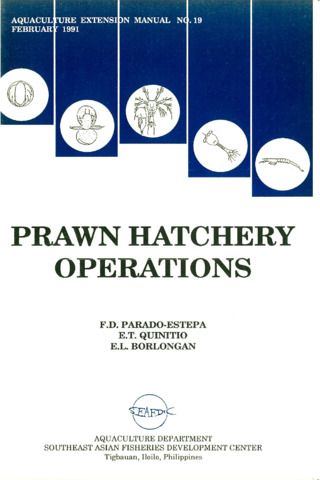Inclusion of live mud polychaete (Marphysa iloiloensis) in the feeding regime improved the hatchery performance of domesticated Indian white shrimp (Penaeus indicus)
| dc.contributor.author | Estante-Superio, Erish | |
| dc.contributor.author | Mandario, Mary Anne | |
| dc.contributor.author | Santander-Avancena, Sheryll | |
| dc.contributor.author | Geanga, Therese Marie M. | |
| dc.contributor.author | Estepa, Fe Dolores | |
| dc.contributor.author | Mamauag, Roger Edward | |
| dc.date.accessioned | 2023-03-13T06:52:42Z | |
| dc.date.available | 2023-03-13T06:52:42Z | |
| dc.date.issued | 2023-03-07 | |
| dc.identifier.citation | Estante-Superio, E. G., Mandario, M. A. E., Santander-Avanceña, S. S., Geanga, T. M. M., Parado-Estepa, F. D., & Mamauag, R. E. P. (2023). Inclusion of live mud polychaete (Marphysa iloiloensis) in the feeding regime improved the hatchery performance of domesticated Indian white shrimp (Penaeus indicus). Regional Studies in Marine Science, 102923. https://doi.org/10.1016/j.rsma.2023.102923 | en |
| dc.identifier.uri | http://hdl.handle.net/10862/6421 | |
| dc.description.abstract | A 60-day feeding trial was conducted to evaluate the effect of inclusion frequency of hatchery-bred mud polychaete, Marphysa iloiloensis, as part of a combination diet on the reproductive performance and larval quality of domesticated P. indicus. The two treatments were fed with a combination of formulated diet, mussel, squid, and mud polychaete with once (T1) and twice (T2) a week inclusion in the feeding regime. In contrast, the control group was fed only a diet combination of mussels, squid, and formulated diet. There was no significant difference in the mean survival of male and female broodstock in all treatments upon termination (\(p\gt0.05)\). Shrimp in T1 and T2 performed significantly better than the control in terms of spawning frequency (\(p=0.037)\) and fertilization rate (\(p=0.001)\), while T1 had significantly high re-maturation (\(p=0.038)\). The survival, spawning, hatching rate, egg, and nauplii production did not differ significantly among treatments (\(p\gt0.05)\). Also, no difference in the gonado-somatic index (GSI), hepato-somatic index (HSI), spermatophore weight, and sperm count was found among diet treatments (\(p\gt0.05)\). Post larvae from T1 and T2 performed significantly better than the control after 25 (\(p=0.008)\) and 30 (\(p=0.009)\) minutes of abrupt exposure to freshwater, respectively. Therefore, even once weekly, mud polychaete inclusion is sufficient to improve the reproductive performance of P. indicus broodstock and produce offspring with boosted resistance in the hatchery. | en |
| dc.description.sponsorship | This study was supported by SEAFDEC/AQD (Study Code: DP-02-C2017T). | en |
| dc.language.iso | en | en |
| dc.publisher | Elsevier | en |
| dc.subject | Penaeus indicus | en |
| dc.subject | Polychaeta | en |
| dc.title | Inclusion of live mud polychaete (Marphysa iloiloensis) in the feeding regime improved the hatchery performance of domesticated Indian white shrimp (Penaeus indicus) | en |
| dc.type | Article | en |
| dc.identifier.doi | 10.1016/j.rsma.2023.102923 | |
| dc.citation.volume | 62 | |
| dc.citation.spage | 102923 | |
| dc.citation.journalTitle | Regional Studies in Marine Science | en |
| dc.subject.asfa | shrimp culture | en |
| dc.subject.asfa | breeding stock | en |
| dc.subject.asfa | diet | en |
| dc.subject.asfa | nutritive value | en |
| dc.subject.asfa | feeding | en |
| dc.subject.asfa | spawning | en |
| dc.subject.asfa | feeding experiments | en |
| dc.identifier.essn | 2352-4855 | |
| dc.subject.scientificName | Marphysa iloiloensis | en |
| dc.subject.scientificName | Penaeus indicus | en |
| local.subject | Hatchery | en |
| local.subject | Nauplii production | en |
| local.subject | Nutrition | en |
| local.subject | Spawning | en |
| local.subject | Salinity stress | en |
このアイテムのファイル
| ファイル | サイズ | フォーマット | 閲覧 |
|---|---|---|---|
|
このアイテムに関連するファイルは存在しません。 |
|||
このアイテムは次のコレクションに所属しています
-
Journal Articles [1229]
These papers were contributed by Department staff to various national and international journals.




